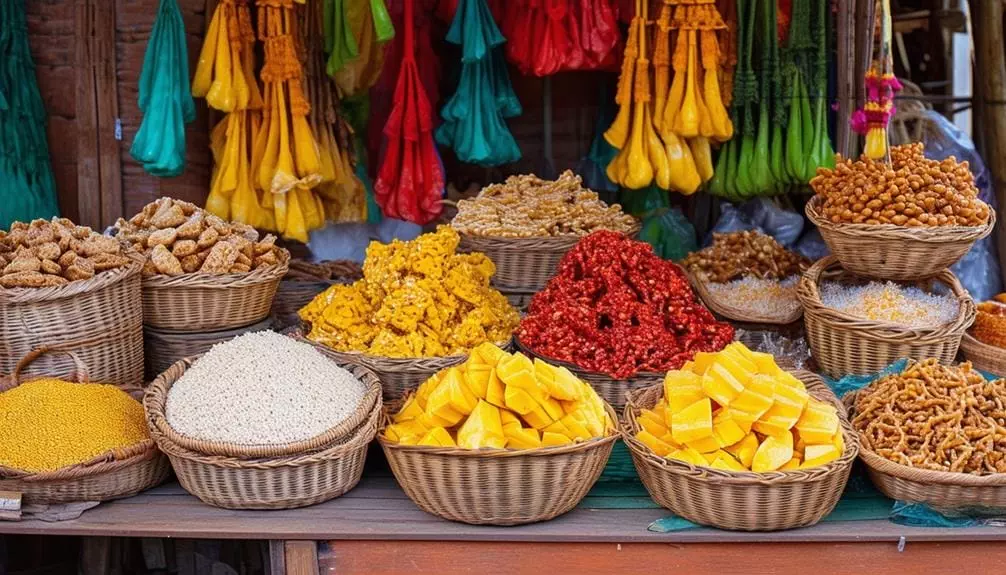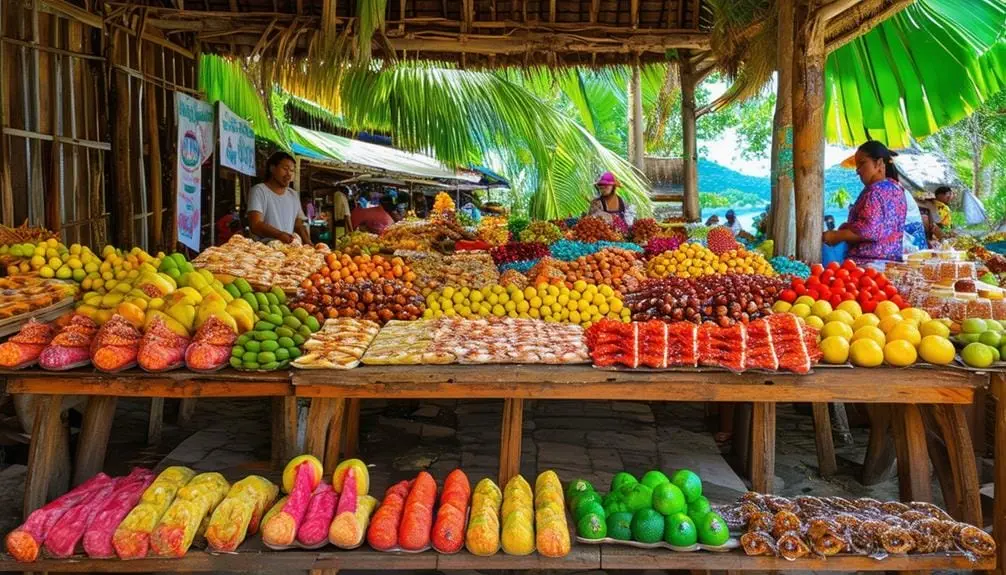Delicacies in Siquijor
When you explore the culinary landscape of Siquijor, you'll find a rich tapestry of flavors waiting to be discovered. Imagine biting into a Torta, the island's signature egg-based pastry, which deepens in flavor over time. Have you ever tried Pan Bisaya, a local bread filled with cheese or meat, perfect alongside a steaming cup of coffee? And what about the traditional peanut treats, meticulously crafted from locally-farmed peanuts? If seafood is your passion, Sutukil offers a fresh, multi-course feast that's simply unforgettable. Ready to uncover what makes these delicacies truly special?
Key Takeaways
- Torta is Siquijor's signature egg-based pastry, improving in flavor with age and popular as a pasalubong.
- Pan Bisaya, a local bread with cheese or meat filling, is enjoyed with hot chocolate or coffee.
- Peanut balls and brittle, crafted from locally-farmed peanuts, are travel-friendly and represent Siquijor's agricultural heritage.
- Sutukil offers fresh seafood cooked three ways: grilling, souping, and ceviche, often enjoyed with sea views.
- ELENAS OTAP, a delicate pastry, and other local delicacies support local entrepreneurs through the Siquijor Association of Food Entrepreneurs.
Torta: Siquijor's Signature Pastry
Siquijor's torta, a demonstration of the island's culinary ingenuity, isn't just any ordinary pastry; it's a flavor journey that unfolds with time. This egg-based delight, often filled with various ingredients, highlights the island province's knack for creating sweet treats that tell a story. Each bite of torta reflects Siquijor's agricultural bounty, using simple, locally-sourced ingredients that capture the nature of the land.
You'll find that torta isn't just a quick snack; it's an experience. Unlike many pastries that lose their charm after a day, torta actually improves with age. This unique characteristic makes it a beloved choice for locals and visitors alike. The deeper, more complex flavors that develop over time make each bite more satisfying than the last.
Local bakeries throughout the island province proudly offer torta, making it easily accessible for anyone keen to taste this traditional sweet treat. It's also a popular pasalubong, allowing you to share a piece of Siquijor's culinary heritage with friends and family back home.
Ultimately, torta isn't just food; it's a delicious tribute to the island's rich cultural and agricultural traditions.
Discovering Pan Bisaya

Discovering Pan Bisaya offers a glimpse into Siquijor's culinary traditions with its simple yet flavorful cheese or meat filling.
You'll find that this local bread, often enjoyed with hot chocolate or coffee, perfectly embodies the island's community spirit and is a popular choice for pasalubong.
Ingredients and Preparation
When it comes to the culinary treasures of Siquijor, Pan Bisaya stands out as a must-try local pastry. The magic of Pan Bisaya lies in its simplicity and the quality of its ingredients. You'll need flour, water, yeast, and your choice of fillings—typically cheese or meat. These basic ingredients, often locally sourced, reflect the island's agricultural roots and contribute to the pastry's authentic flavor.
To prepare Pan Bisaya, start by kneading the dough until it's smooth and elastic. This process is essential for developing the right texture. Once kneaded, the dough needs time to rise, allowing the yeast to work its wonders and create a light, airy structure.
After the rising phase, shape the dough into individual rolls, carefully adding your chosen fillings. Whether you opt for the savory tang of cheese or the hearty satisfaction of meat, each filling brings its own unique charm to the pastry.
Bake these filled rolls to golden perfection, ensuring a crispy exterior that gives way to a soft, flavorful interior. While Pan Bisaya is best enjoyed fresh, its taste intriguingly improves over time, making it a delightful treat for both locals and visitors alike.
Pairing Suggestions
Exploring the perfect pairings for Pan Bisaya can elevate your culinary experience to new heights. This delightful bread, often filled with cheese or meat, is a versatile treat that fits various dining occasions.
Start your day by pairing Pan Bisaya with a steaming cup of hot chocolate or coffee. The warm beverage enhances the bread's rich taste and soft texture, offering a comforting start to your morning.
As you wander through Siquijor island, you'll find Pan Bisaya in local bakeries, each offering an authentic taste of the region's culinary traditions. To create a more substantial meal, consider pairing this local delicacy with Sutukil, a beloved trio of dishes featuring fresh seafood.
The combination of Pan Bisaya's savory filling and the fresh, zesty flavors of Sutukil offers a satisfying contrast that highlights the island's diverse food offerings.
Pan Bisaya's appeal doesn't wane over time, making it a perfect snack to savor throughout the day. Whether paired with simple beverages or more elaborate local delicacies, this bread showcases the best of Siquijor's culinary landscape, inviting you to indulge in its unique flavors and textures.
Cultural Significance
Pan Bisaya isn't just a delightful bread; it's a culinary emblem of Siquijor's rich heritage. This traditional bread, often filled with cheese or meat, isn't merely about taste. It showcases the island's agricultural pride, using locally sourced ingredients that underscore Siquijor's commitment to farm-to-table practices.
When you bite into Pan Bisaya with a steaming cup of hot chocolate or coffee, you're not just enjoying a meal; you're partaking in a cultural ritual that binds the community.
It's fascinating how the simplicity of Pan Bisaya has evolved over time, adapting in flavor and texture while remaining a beloved comfort food. You can find this delicacy in local markets and bakeries, making it a staple snack or breakfast item for both residents and visitors.
Sharing Pan Bisaya during gatherings isn't just about food; it helps us connect, reinforcing social bonds and cultural traditions that are essential to the island's communal spirit.
In Siquijor, Pan Bisaya isn't just another bread; it's a must-try product that tells the story of the island's rich cultural tapestry. So, when you're exploring Siquijor, don't miss out on this iconic delicacy.
Peanut Balls and Brittle

You'll find that Peanut Balls and Peanut Brittle from Siquijor aren't just tasty treats but also a representation of the island's rich agricultural heritage.
Using locally-farmed peanuts, these snacks are crafted through traditional methods, ensuring both convenience and quality.
Their travel-friendly packaging makes them perfect for pasalubong, allowing you to share a piece of Siquijor's culinary culture wherever you go.
Local Ingredients Highlight
Among the various local ingredients that define Siquijor's culinary landscape, peanuts hold a place of prominence. Locally-farmed peanuts are often used to create two beloved snacks: peanut balls and peanut brittle. These treats, mixed with flour in the case of peanut balls, showcase the island's agricultural richness and traditional culinary techniques.
Peanut balls are a sweet and convenient snack, made by combining freshly roasted peanuts with flour and local sweeteners, then shaped into bite-sized delights. The result is a satisfying blend of crunch and sweetness, perfect for a quick energy boost or a delightful treat during your island explorations.
Peanut brittle, on the other hand, highlights the simplicity and deliciousness of caramelized peanuts. This delicacy features whole peanuts encased in a crunchy caramel shell, creating a perfect balance of nutty and sweet flavors. It's often shared among friends and family, embodying the communal spirit of Siquijor.
Both peanut balls and brittle not only offer a taste of the island but also reflect the traditional preparation methods that enhance their authentic flavors. You can commonly find these snacks in local markets, making them popular choices for pasalubong, or souvenirs, to share your Siquijor experience with loved ones.
Travel-Friendly Snacks
Traveling through the enchanting island of Siquijor, you'll quickly realize the convenience and delight of its travel-friendly snacks, particularly peanut balls and brittle. These treats are perfect companions for your journey, offering a taste of local culture with every bite.
Peanut balls, made from locally-farmed peanuts, are a sweet and portable snack that embodies the island's rich agricultural heritage. Their compact size makes them easy to carry, and their flavor profile, a harmonious blend of sweetness and nuttiness, guarantees a satisfying snack experience.
They're ideal for quick breaks during your adventures, keeping your energy levels up as you explore.
Peanut brittle, another favorite, combines caramelized peanuts into a crunchy, shareable confection. Its robust flavor and texture make it a versatile snack, whether you're munching on it solo or sharing with newfound friends.
Easy to pack, peanut brittle fits seamlessly into your travel bag, making it an essential item for any journey.
Both snacks not only highlight Siquijor's local produce but also serve as popular pasalubong (souvenirs) among travelers.
For those seeking practical travel tips, stock up on these delicious delicacies from local markets; they're perfect for savoring the island's authentic flavors on the go.
Traditional Preparation Methods
Exploring the traditional preparation methods of Siquijor's beloved peanut balls and brittle offers a deeper appreciation for these delightful snacks.
You'll find that the process begins with locally-farmed peanuts, a reflection of the island's agricultural heritage. For peanut balls, artisans grind these peanuts and mix them with sugar, using family recipes passed down through generations. The mixture is then hand-shaped into small, convenient balls, allowing you to savor the local flavors in every bite.
Peanut brittle, on the other hand, involves caramelizing sugar before adding roasted peanuts. The blend is meticulously spread out to cool and then broken into shareable pieces. This intricate process highlights the artisan techniques that make each piece unique.
These traditional methods are more than just steps; they're a cultural experience. You'll appreciate how the handcrafting guarantees the authenticity and quality of each snack.
Furthermore, their convenient packaging makes them perfect for pasalubong, allowing you to share a piece of Siquijor with friends and family. Embracing these time-honored techniques means you're not just tasting a snack—you're experiencing a slice of Siquijor's rich heritage.
Sutukil: Fresh Catch Feast

Sutukil: Fresh Catch Feast is a quintessential dining experience in Siquijor that showcases the island's rich marine bounty through three distinct cooking methods: grilling (sugba), souping (sinigang), and preparing ceviche (kilawin). You'll relish in Sutukil Variations, where you can select from the freshest seafood like fish, shrimp, and shellfish. This freedom to choose guarantees Seafood Freshness, making every bite a true taste of the sea.
| Cooking Method | Description |
|---|---|
| Sugba | Grilled to perfection |
| Sinigang | Simmered in savory broth |
| Kilawin | Marinated in citrus juices |
Dining Atmosphere plays a crucial role in the Sutukil experience. Many local restaurants are perched right by the sea, letting you enjoy your meal with the sound of waves and a salty breeze. The open-air settings and rustic charm of these establishments enhance your connection to the ocean and elevate the overall dining experience.
In Siquijor, Sutukil isn't just a meal—it's an immersion into the island's culture and natural wealth. The combination of fresh ingredients and traditional cooking techniques brings out the authentic flavors that define this must-try delicacy.
Traditional Cooking Methods

When it comes to traditional cooking methods in Siquijor, the island's culinary practices are deeply rooted in its rich agricultural heritage and diverse ecosystem. You'll find that many dishes prominently feature coconut, a staple ingredient in Siquijor cuisine. Coconut uses vary widely, from roasting and boiling to incorporating coconut milk for a creamy texture and rich flavor.
Grilling techniques are another cornerstone of Siquijor's culinary tradition. Fresh seafood, often caught the same day, is prepared on open flames. This method enhances the natural flavors of the fish, shrimp, or squid, making every bite a demonstration of the island's bounty.
Seafood preparation doesn't stop at the grill. Ceviche, or kinilaw, is a popular dish that uses raw fish marinated in vinegar and citrus juices. This simple yet flavorful preparation highlights the freshness of the seafood and the island's emphasis on natural, unadulterated flavors.
Traditional herbal remedies also find their way into the kitchen. Ingredients like ginger and turmeric are commonly used, reflecting the island's deep connection to herbal medicine and adding layers of complexity and health benefits to the dishes.
Culinary Souvenirs

While Siquijor's traditional cooking methods showcase the island's rich culinary heritage, the journey doesn't end at the dining table. You can bring home a piece of this gastronomic paradise through its diverse range of culinary souvenirs.
Peanut Brittle and Peanut Balls, crafted from locally-farmed peanuts, offer unique flavor profiles that are both sweet and savory—perfect for snacking on the go.
Torta, an egg-based pastry, is another must-try. Its flavor matures over time, making it an excellent, long-lasting gift. You'll find these treats in local food markets, where engaging with sellers often leads to discovering the best picks and learning souvenir packaging tips to guarantee freshness during travel.
Pan Bisaya, filled with cheese or meat, pairs wonderfully with hot chocolate or coffee, offering a comforting reminder of your Siquijor adventure.
ELENAS OTAP, a wafer-thin sweetened cracker, stands out for its delicate, unique flavors, making it a cherished gift.
Supporting local entrepreneurs through the Siquijor Association of Food Entrepreneurs (AFE) not only assures authenticity but also boosts the island's economy.
Frequently Asked Questions
What Is the Famous Delicacy in Siquijor?
You can't miss Torta in Siquijor. This famous delicacy reflects Siquijor culinary traditions and local cooking techniques. It often shines during traditional food festivals, offering a delightful taste that improves with time. Enjoy its unique flavor!
What Is the Famous Fruit in Siquijor?
In Siquijor, the famous fruit isn't mangoes, but Lanzones. You'll find its tropical flavors irresistible. Visit local markets from September to November to enjoy this sweet, juicy fruit at its peak ripeness, rich in vitamins and health benefits.
What Is Siquijor Philippines Known For?
You'll find that Siquijor is known for its rich culture, vibrant local traditions, and exciting culinary festivals. The island's unique blend of history and cuisine offers an immersive experience that celebrates freedom and creativity. If you’re a fan of water activities, you may also want to explore the top water attractions in Cebu, which offer a range of adrenaline-pumping experiences such as snorkeling, scuba diving, and island hopping. With its crystal-clear waters and diverse marine life, Cebu is a paradise for water enthusiasts looking to explore the beauty of the Philippine archipelago. Whether you’re admiring the stunning coral reefs or swimming alongside majestic sea creatures, Cebu’s aquatic adventures are not to be missed. For a more tranquil escape, consider visiting the Virgin Island Cebu highlights, where you can unwind on pristine white-sand beaches and enjoy the serene beauty of untouched nature. This hidden gem is perfect for those seeking a peaceful retreat away from the crowds, offering breathtaking views and a chance to reconnect with the simplicity of island life. Combine this with the vibrant energy of Siquijor and Cebu’s water attractions for a truly unforgettable Philippine adventure.
What Is the Native Bread in Siquijor?
You'll find the native bread in Siquijor is made from native ingredients like rice flour and coconut milk. Through traditional baking methods, it captures local flavors, making it a unique and authentic culinary experience.
Conclusion
You've now got a taste of Siquijor's rich culinary tapestry. From the maturing flavors of Torta to the communal joy of Pan Bisaya, and the artisanal touch in peanut treats, every bite tells a story. Sutukil offers a fresh seafood experience that's unparalleled. The island's traditional cooking methods highlight its agricultural bounty. Don't leave without culinary souvenirs; they're perfect reminders of Siquijor's unique gastronomy. Immerse yourself and savor the island's distinctive flavors.






